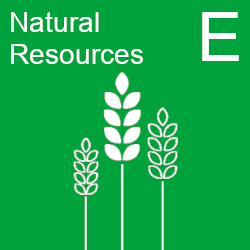Notice: From 01 December 2025, the Outcome Indicator Framework dashboard has been moved. Future updates to this publication are available on GOV.UK at: Environmental Indicator Framework.
Short Description
Farming produces a range of food, feed and fibre commodities. This represents a valuable output from the land and other resources used. Volume of agricultural production is considered to be a provisioning service provided by a range of natural capital assets (land, water, air, species and ecological communities). This indicator shows annual changes in the index of output volume which provides an overall measure of total production across the wide range of agricultural commodities. The index is calculated using agreed international standards.
Farm practices and the use of inputs (particularly fertilisers and pesticides) directly influence the environmental pressures from farming including the quality, composition and availability of habitats and impact on air, water and soils. This indicator should therefore be viewed alongside indicator ‘E3 Volume of inputs used in agricultural production’ and other indicators in the framework relating to the condition of natural capital assets.
Readiness and links to data
The data presented in this indicator are derived from the official statistics on total factor productivity for England by farm type. These total factor productivity data are collated via the Farm Business Survey and are updated annually.
Indicator components
Figure E2: Volume of agricultural production in England, 1990/1991 to 2023/2024
Table E2: Volume of agricultural production in England, 1990/1991 to 2023/2024
| Year | Value |
|---|---|
| 1990/1991 | 100.00 |
| 1991/1992 | 103.56 |
| 1992/1993 | 98.85 |
| 1993/1994 | 93.73 |
| 1994/1995 | 94.72 |
| 1995/1996 | 100.62 |
| 1996/1997 | 101.77 |
| 1997/1998 | 101.51 |
| 1998/1999 | 100.23 |
| 1999/2000 | 101.20 |
| 2000/2001 | 91.79 |
| 2001/2002 | 100.20 |
| 2002/2003 | 106.01 |
| 2003/2004 | 107.90 |
| 2004/2005 | 108.95 |
| 2005/2006 | 106.60 |
| 2006/2007 | 104.91 |
| 2007/2008 | 99.58 |
| 2008/2009 | 105.05 |
| 2009/2010 | 100.77 |
| 2010/2011 | 99.84 |
| 2011/2012 | 103.66 |
| 2012/2013 | 95.06 |
| 2013/2014 | 98.58 |
| 2014/2015 | 105.14 |
| 2015/2016 | 106.50 |
| 2016/2017 | 102.06 |
| 2017/2018 | 104.10 |
| 2018/2019 | 107.18 |
| 2019/2020 | 110.36 |
| 2020/2021 | 102.21 |
| 2021/2022 | 103.18 |
| 2022/2023 | 106.66 |
| 2023/2024 | 102.43 |
Trend description for E2
Since the start of the series in 1990/1991, the overall volume of agricultural production (outputs) in England has remained relatively stable, with some variation from year to year. Annual variations are generally driven by external factors, in particular, the weather affecting growing and harvest, and the variation in cropping driven by prices. In recent years, following a reduction in 2020/2021 attributed to decreases in crop output, livestock meat and livestock products, there was a slight increase between 2021/2022 and 2022/2023, followed by a 4.0% decrease in 2023/2024.
Assessment of change
An increase in volume of agricultural production has been observed over the medium and long term. However, it is not possible to categorise this increase as either a simplistic ‘improvement’ or ‘deterioration’ as this will depend on numerous factors around farming practices. There was little to no change in the short term. This indicator is included in the Outcome Indicator Framework to help interpret the reasons behind changes in ‘E4 Efficiency of agricultural production measured by Total Factor Productivity’, rather than to assess progress for a policy driver in the 25 Year Environment Plan.
Change since 2018 has also been assessed. There has been little or no change in volume of agricultural production since 2018.
Further information on this assessment, along with details on the methodology, is provided in the Assessment background page. Summaries by 25 Year Environment Plan goal and information on indicator links are presented in the Assessment results pages.
Table E2: Assessment of change
| Component | Period | Date range | Percentage change | Smoothing function | Assessment of change |
|---|---|---|---|---|---|
| E2 | Short term | 2018/2019 to 2023/2024 | 2.10 | Loess | Little or no change |
| E2 | Medium term | 2013/2014 to 2023/2024 | 4.02 | Loess | Change (increasing) |
| E2 | Long term | 1990/1991 to 2023/2024 | 6.90 | Loess | Change (increasing) |
Note that assessment categories were assigned based on smoothed data, so percentage change figures in Table E2 may differ from unsmoothed values quoted elsewhere. It is not possible to define a simplistic desired direction of change for this indicator so we cannot assign an ‘improvement’ or ‘deterioration’ label to these results.

